(Jeff Drouin is in the English Ph.D. Program at The Graduate Center of the City University of New York)
About three weeks ago I had lunch with Ben, Eddie, Dan, and Jesse to talk about starting a community with one of my projects, the Ecclesiastical Proust Archive. I heard of the Institute for the Future of the Book some time ago in a seminar meeting (I think) and began reading the blog regularly last Summer, when I noticed the archive was mentioned in a comment on Sarah Northmore’s post regarding Hurricane Katrina and print publishing infrastructure. The Institute is on the forefront of textual theory and criticism (among many other things), and if:book is a great model for the kind of discourse I want to happen at the Proust archive. When I finally started thinking about how to make my project collaborative I decided to contact the Institute, since we’re all in Brooklyn, to see if we could meet. I had an absolute blast and left their place swimming in ideas!
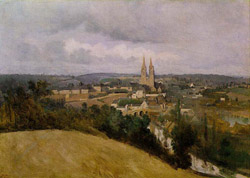 While my main interest was in starting a community, I had other ideas — about making the archive more editable by readers — that I thought would form a separate discussion. But once we started talking I was surprised by how intimately the two were bound together.
While my main interest was in starting a community, I had other ideas — about making the archive more editable by readers — that I thought would form a separate discussion. But once we started talking I was surprised by how intimately the two were bound together.
For those who might not know, The Ecclesiastical Proust Archive is an online tool for the analysis and discussion of à la recherche du temps perdu (In Search of Lost Time). It’s a searchable database pairing all 336 church-related passages in the (translated) novel with images depicting the original churches or related scenes. The search results also provide paratextual information about the pagination (it’s tied to a specific print edition), the story context (since the passages are violently decontextualized), and a set of associations (concepts, themes, important details, like tags in a blog) for each passage. My purpose in making it was to perform a meditation on the church motif in the Recherche as well as a study on the nature of narrative.
I think the archive could be a fertile space for collaborative discourse on Proust, narratology, technology, the future of the humanities, and other topics related to its mission. A brief example of that kind of discussion can be seen in this forum exchange on the classification of associations. Also, the church motif — which some might think too narrow — actually forms the central metaphor for the construction of the Recherche itself and has an almost universal valence within it. (More on that topic in this recent post on the archive blog).
Following the if:book model, the archive could also be a spawning pool for other scholars’ projects, where they can present and hone ideas in a concentrated, collaborative environment. Sort of like what the Institute did with Mitchell Stephens’ Without Gods and Holy of Holies, a move away from the ‘lone scholar in the archive’ model that still persists in academic humanities today.
One of the recurring points in our conversation at the Institute was that the Ecclesiastical Proust Archive, as currently constructed around the church motif, is “my reading” of Proust. It might be difficult to get others on board if their readings — on gender, phenomenology, synaesthesia, or whatever else — would have little impact on the archive itself (as opposed to the discussion spaces). This complex topic and its practical ramifications were treated more fully in this recent post on the archive blog.
I’m really struck by the notion of a “reading” as not just a private experience or a public writing about a text, but also the building of a dynamic thing. This is certainly an advantage offered by social software and networked media, and I think the humanities should be exploring this kind of research practice in earnest. Most digital archives in my field provide material but go no further. That’s a good thing, of course, because many of them are immensely useful and important, such as the Kolb-Proust Archive for Research at the University of Illinois, Urbana-Champaign. Some archives — such as the NINES project — also allow readers to upload and tag content (subject to peer review). The Ecclesiastical Proust Archive differs from these in that it applies the archival model to perform criticism on a particular literary text, to document a single category of lexia for the experience and articulation of textuality.
 If the Ecclesiastical Proust Archive widens to enable readers to add passages according to their own readings (let’s pretend for the moment that copyright infringement doesn’t exist), to tag passages, add images, add video or music, and so on, it would eventually become a sprawling, unwieldy, and probably unbalanced mess. That is the very nature of an Archive. Fine. But then the original purpose of the project — doing focused literary criticism and a study of narrative — might be lost.
If the Ecclesiastical Proust Archive widens to enable readers to add passages according to their own readings (let’s pretend for the moment that copyright infringement doesn’t exist), to tag passages, add images, add video or music, and so on, it would eventually become a sprawling, unwieldy, and probably unbalanced mess. That is the very nature of an Archive. Fine. But then the original purpose of the project — doing focused literary criticism and a study of narrative — might be lost.
If the archive continues to be built along the church motif, there might be enough work to interest collaborators. The enhancements I currently envision include a French version of the search engine, the translation of some of the site into French, rewriting the search engine in PHP/MySQL, creating a folksonomic functionality for passages and images, and creating commentary space within the search results (and making that searchable). That’s some heavy work, and a grant would probably go a long way toward attracting collaborators.
So my sense is that the Proust archive could become one of two things, or two separate things. It could continue along its current ecclesiastical path as a focused and led project with more-or-less particular roles, which might be sufficient to allow collaborators a sense of ownership. Or it could become more encyclopedic (dare I say catholic?) like a wiki. Either way, the organizational and logistical practices would need to be carefully planned. Both ways offer different levels of open-endedness. And both ways dovetail with the very interesting discussion that has been happening around Ben’s recent post on the million penguins collaborative wiki-novel.
Right now I’m trying to get feedback on the archive in order to develop the best plan possible. I’ll be demonstrating it and raising similar questions at the Society for Textual Scholarship conference at NYU in mid-March. So please feel free to mention the archive to anyone who might be interested and encourage them to contact me at jdrouin@gc.cuny.edu. And please feel free to offer thoughts, comments, questions, criticism, etc. The discussion forum and blog are there to document the archive’s development as well.
Thanks for reading this very long post. It’s difficult to do anything small-scale with Proust!
Category Archives: peer_review
scholarpedia: sharpening the wiki for expert results
Eugene M. Izhikevich, a Senior Fellow in Theoretical Neurobiology at The Neurosciences Institute in San Diego, wants to see if academics can collaborate to produce a peer reviewed equivalent to Wikipedia. The attempt is Scholarpedia, a free peer reviewed encyclopedia, entirely open to public contributions but with editorial oversight by experts.
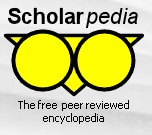 At first, this sounded to me a lot like Larry Sanger’s Citizendium project, which will attempt to add an expert review layer to material already generated by Wikipedia (they’re calling it a “progressive fork” off of the Wikipedia corpus). Sanger insists that even with this added layer of control the open spirit of Wikipedia will live on in Citizendium while producing a more rigorous and authoritative encyclopedia.
At first, this sounded to me a lot like Larry Sanger’s Citizendium project, which will attempt to add an expert review layer to material already generated by Wikipedia (they’re calling it a “progressive fork” off of the Wikipedia corpus). Sanger insists that even with this added layer of control the open spirit of Wikipedia will live on in Citizendium while producing a more rigorous and authoritative encyclopedia.
It’s always struck me more as a simplistic fantasy of ivory tower-common folk détente than any reasoned community-building plan. We’ll see if Walesism and Sangerism can be reconciled in a transcendent whole, or if intellectual class warfare (of the kind that has already broken out on multiple occasions between academics and general contributors on Wikipedia) — or more likely inertia — will be the result.
The eight-month-old Scholarpedia, containing only a few dozen articles and restricted for the time being to three neuroscience sub-fields, already feels like a more plausible proposition, if for no other reason than that it knows who its community is and that it establishes an unambiguous hierarchy of participation. Izhikevich has appointed himself editor-in-chief and solicited full articles from scholarly peers around the world. First the articles receive “in-depth, anonymous peer review” by two fellow authors, or by other reviewers who measure sufficiently high on the “scholar index.” Peer review, it is explained, is employed both “to insure the accuracy and quality of information” but also “to allow authors to list their papers as peer-reviewed in their CVs and resumes” — a marriage of pragmaticism and idealism in Mr. Izhikevich.
After this initial vetting, the article is officially part of the Scholarpedia corpus and is hence open to subsequent revisions and alterations suggested by the community, which must in turn be accepted by the author, or “curator,” of the article. The discussion, or “talk” pages, familiar from Wikipedia are here called “reviews.” So far, however, it doesn’t appear that many of the approved articles have received much of a public work-over since passing muster in the initial review stage. But readers are weighing in (albeit in modest numbers) in the public election process for new curators. I’m very curious to see if this will be treated by the general public as a read-only site, or if genuine collaboration will arise.
It’s doubtful that this more tightly regulated approach could produce a work as immense and varied as Wikipedia, but it’s pretty clear that this isn’t the goal. It’s a smaller, more focused resource that Izhikevich and his curators are after, with an eye toward gradually expanding to embrace all subjects. I wonder, though, if the site wouldn’t be better off keeping its ambitions concentrated, renaming itself something like “Neuropedia” and looking simply to inspire parallel efforts in other fields. One problem of open source knowledge projects is that they’re often too general in scope (Scholarpedia says it all). A federation of specialized encyclopedias, produced by focused communities of scholars both academic and independent — and with some inter-disciplinary porousness — would be a more valuable, if less radical, counterpart to Wikipedia, and more likely to succeed than the Citizendium chimera.
perelman’s proof / wsj on open peer review
Last week got off to an exciting start when the Wall Street Journal ran a story about “networked books,” the Institute’s central meme and very own coinage. It turns out we were quoted in another WSJ item later that week, this time looking at the science journal Nature, which over the summer has been experimenting with opening up its peer review process to the scientific community (unfortunately, this article, like the networked books piece, is subscriber only).
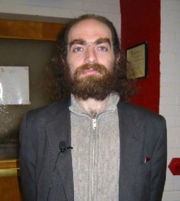 I like this article because it smartly weaves in the story of Grigory (Grisha) Perelman, which I had meant to write about earlier. Perelman is a Russian topologist who last month shocked the world by turning down the Fields medal, the highest honor in mathematics. He was awarded the prize for unraveling a famous geometry problem that had baffled mathematicians for a century.
I like this article because it smartly weaves in the story of Grigory (Grisha) Perelman, which I had meant to write about earlier. Perelman is a Russian topologist who last month shocked the world by turning down the Fields medal, the highest honor in mathematics. He was awarded the prize for unraveling a famous geometry problem that had baffled mathematicians for a century.
There’s an interesting publishing angle to this, which is that Perelman never submitted his groundbreaking papers to any mathematics journals, but posted them directly to ArXiv.org, an open “pre-print” server hosted by Cornell. This, combined with a few emails notifying key people in the field, guaranteed serious consideration for his proof, and led to its eventual warranting by the mathematics community. The WSJ:
…the experiment highlights the pressure on elite science journals to broaden their discourse. So far, they have stood on the sidelines of certain fields as a growing number of academic databases and organizations have gained popularity.
One Web site, ArXiv.org, maintained by Cornell University in Ithaca, N.Y., has become a repository of papers in fields such as physics, mathematics and computer science. In 2002 and 2003, the reclusive Russian mathematician Grigory Perelman circumvented the academic-publishing industry when he chose ArXiv.org to post his groundbreaking work on the Poincaré conjecture, a mathematical problem that has stubbornly remained unsolved for nearly a century. Dr. Perelman won the Fields Medal, for mathematics, last month.
(Warning: obligatory horn toot.)
“Obviously, Nature’s editors have read the writing on the wall [and] grasped that the locus of scientific discourse is shifting from the pages of journals to a broader online conversation,” wrote Ben Vershbow, a blogger and researcher at the Institute for the Future of the Book, a small, Brooklyn, N.Y., , nonprofit, in an online commentary. The institute is part of the University of Southern California’s Annenberg Center for Communication.
Also worth reading is this article by Sylvia Nasar and David Gruber in The New Yorker, which reveals Perelman as a true believer in the gift economy of ideas:
Perelman, by casually posting a proof on the Internet of one of the most famous problems in mathematics, was not just flouting academic convention but taking a considerable risk. If the proof was flawed, he would be publicly humiliated, and there would be no way to prevent another mathematician from fixing any errors and claiming victory. But Perelman said he was not particularly concerned. “My reasoning was: if I made an error and someone used my work to construct a correct proof I would be pleased,” he said. “I never set out to be the sole solver of the Poincaré.”
Perelman’s rejection of all conventional forms of recognition is difficult to fathom at a time when every particle of information is packaged and owned. He seems almost like a kind of mystic, a monk who abjures worldly attachment and dives headlong into numbers. But according to Nasar and Gruber, both Perelman’s flouting of academic publishing protocols and his refusal of the Fields medal were conscious protests against what he saw as the petty ego politics of his peers. He claims now to have “retired” from mathematics, though presumably he’ll continue to work on his own terms, in between long rambles through the streets of St. Petersburg.
Regardless, Perelman’s case is noteworthy as an example of the kind of critical discussions that scholars can now orchestrate outside the gate. This sort of thing is generally more in evidence in the physical and social sciences, but ought too to be of great interest to scholars in the humanities, who have only just begun to explore the possibilities. Indeed, these are among our chief inspirations for MediaCommons.
Academic presses and journals have long functioned as the gatekeepers of authoritative knowledge, determining which works see the light of day and which ones don’t. But open repositories like ArXiv have utterly changed the calculus, and Perelman’s insurrection only serves to underscore this fact. Given the abundance of material being published directly from author to public, the critical task for the editor now becomes that of determining how works already in the daylight ought to be received. Publishing isn’t an endpoint, it’s the beginning of a process. The networked press is a guide, a filter, and a discussion moderator.
Nature seems to grasp this and is trying with its experiment to reclaim some of the space that has opened up in front of its gates. Though I don’t think they go far enough to effect serious change, their efforts certainly point in the right direction.
MediaCommons 2: renewed publics, revised pedagogies
What a week it has been since Kathleen first posted about the MediaCommons project we are developing at the Institute for the Future of the Book. The responses we’ve received so far have mostly been both exciting and constructive and they clearly point to a community out there hungry for a digital scholarly network providing new opportunities for interaction and new modes of scholarship, pedagogy and community building.
As a co-creator with Christopher Lucas of Flow: A critical forum on television and media culture, an online journal intended to foster accessible and relevant conversations amongst media scholars and non-academic communities, I have seen first-hand the positive impact that more fluid exchanges of ideas can have on media studies scholarship. Flow’s mission is to provide a space where researchers, teachers, students, and the public can read about and discuss the changing landscape of contemporary media at the speed that media moves. Flow is organized around short, topical columns written by respected media scholars on a bi-weekly schedule. These columns invite response from the critical community by asking provocative questions that are significant to the study and experience of media.
The journal has been put to use in various classroom environments as well, with students either responding to pieces online or the inclusion of various columns in course packets, though this aspect of Flow’s mission has never achieved it’s fullest potential. Moreover, while the journal has been a phenomenal success amongst media studies scholars, it has largely failed to attract other constituencies on a consistent basis or engage them in critical conversations about media. My involvement with MediaCommons emerges out of a desire to make these scholarly conversations relevant to other constituencies — whether they be media producers, legislators, lobbyists, activists, students, or informed consumers — re-establishing the role of the academic as public intellectual and steward or critical conversations.
Today, I am going to write a little bit more about the pedagogical and community outreach goals of the site. These ideas are still being developed and we are hopeful that readers will chime in with other possibilities and suggestions as well. While I will discuss each of these subjects separately, one of the exciting opportunities with MediaCommons would be the integration of scholarly discourse, pedagogy, and community outreach in symbiotic ways.
cover story in chronicle of higher ed.
Which focuses primarily on GAM3R 7H30RY and MediaCommons, and implications for the future of scholarly discourse. There are substantial interview sections with McKenzie Wark and Kathleen Fitzpatrick. We’re excited.
Check it out:
– Chronicle subscribers
– Open URL
initial responses to MediaCommons
…have been quite encouraging. In addition to a very active and thought-provoking thread here on if:book, much has been blogged around the web over the past 48 hours. I’m glad to see that most of the responses around the web have zeroed in on the most crucial elements of our proposal, namely the reconfiguration of scholarly publishing into an open, process-oriented model, a fundamental re-thinking of peer review, and the goal of forging stronger communication between the academy and the publics it claims to serve. To a great extent, this can be credited to Kathleen’s elegant and lucid presentation the various pieces of this complex network we hope to create (several of which will be fleshed out in a post by Avi Santo this coming Monday). Following are selections from some of the particularly thoughtful and/or challenging posts.
Many are excited/intrigued by how MediaCommons will challenge what is traditionally accepted as scholarship:
In Ars Technica, “Breaking paper’s stranglehold on the academy“:
…what’s interesting about MediaCommons is the creators’ plan to make the site “count” among other academics. Peer review will be incorporated into most of the projects with the goal of giving the site the same cachet that print journals currently enjoy.
[…]
While many MediaCommons projects replicate existing academic models, others break new ground. Will contributing to a wiki someday secure a lifetime Harvard professorship? Stranger things have happened. The humanities has been wedded to an individualist research model for centuries; even working on collaborative projects often means going off and working alone on particular sections. Giving credit for collaboratively-constructed wikis, no matter how good they are, might be tricky when there are hundreds of authors. How would a tenure committee judge a person’s contributions?
And here’s librarian blogger Kris Grice, “Blogging for tenure?“:
…the more interesting thrust of the article, in my opinion, is the quite excellent point that open access systems won’t work unless the people who might be contributing have some sort of motivation to spend vast amounts of time and energy on publishing to the Web. To this end, the author suggests pushing to have participation in wikis, blogs, and forums count for tenure.
[…]
If you’re out there writing a blog or adding to a library wiki or doing volunteer reference through IRC or chat or IM, I’d strongly suggest you note URLs and take screenshots of your work. I am of the firm opinion that these activities count as “service to the profession” as much as attending conferences do– especially if you blog the conferences!
A bunch of articles characterize MediaCommons as a scholarly take on Wikipedia, which is interesting/cool/a little scary:
The Chronicle of Higher Education’s Wired Campus Blog, “Academics Start Their Own Wikipedia For Media Studies“:
MediaCommons will try a variety of new ideas to shake up scholarly publishing. One of them is essentially a mini-Wikipedia about aspects of the discipline.
And in ZD Net Education:
The model is somewhat like a Wikipedia for scholars. The hope is that contributions would be made by members which would eventually lead to tenure and promotion lending the project solid academic scholarship.
Now here’s Chuck Tryon, at The Chutry Experiment, on connecting scholars to a broader public:
I think I’m most enthusiastic about this project…because it focuses on the possibilities of allowing academics to write for audiences of non-academics and strives to use the network model to connect scholars who might otherwise read each other in isolation.
[…]
My initial enthusiasm for blogging grew out of a desire to write for audiences wider than my academic colleagues, and I think this is one of many arenas where MediaCommons can provide a valuable service. In addition to writing for this wider audience, I have met a number of media studies scholars, filmmakers, and other friends, and my thinking about film and media has been shaped by our conversations.
(As I’ve mentioned before, MediaCommons grew out of an initial inquiry into academic blogging as an emergent form of public intellectualism.)
A little more jaded, but still enthusiastic, is Anne Galloway at purse lip square jaw:
I think this is a great idea, although I confess to wishing we were finally beyond the point where we feel compelled to place the burden on academics to prove our worthiness. Don’t get me wrong – I believe that academic elitism is problematic and I think that traditional academic publishing is crippled by all sorts of internal and external constraints. I also think that something like MediaCommons offers a brilliant complement and challenge to both these practices. But if we are truly committed to greater reciprocity, then we also need to pay close attention to what is being given and taken. I started blogging in 2001 so that I could participate in exactly these kinds of scholarly/non-scholarly networks, and one of the things I’ve learned is that the give-and-take has never been equal, and only sometimes has it been equitable. I doubt that this or any other technologically-mediated network will put an end to anti-intellectualism from the right or the left, but I’m all for seeing what kinds of new connections we can forge together.
A few warn of the difficulties of building intellectual communities on the web:
Noah Wardrip-Fruin at Grand Text Auto (and also in a comment here on if:book):
I think the real trick here is going to be how they build the network. I suspect a dedicated community needs to be built before the first ambitious new project starts, and that this community is probably best constructed out of people who already have online scholarly lives to which they’re dedicated. Such people are less likely to flake, it seems to me, if they commit. But will they want to experiment with MediaCommons, given they’re already happy with their current activity? Or, can their current activity, aggregated, become the foundation of MediaCommons in a way that’s both relatively painless and clearly shows benefit? It’s an exciting and daunting road the Institute folks have mapped out for themselves, and I’m rooting for their success.
And Charlie Lowe at Kairosnews:
From a theoretical standpoint, this is an exciting collection of ideas for a new scholarly community, and I wish if:book the best in building and promoting MediaCommons.
From a pragmatic standpoint, however, I would offer the following advice…. The “If We Build It, They Will Come” strategy of web community development is laudable, but often doomed to failure. There are many projects around the web which are inspired by great ideas, yet they fail. Installing and configuring a content management system website is the easy part. Creating content for the site and building a community of people who use it is much harder. I feel it is typically better to limit the scope of a project early on and create a smaller community space in which the project can grow, then add more to serve the community’s needs over time.
My personal favorite. Jeff Rice (of Wayne State) just posted a lovely little meditation on reading Richard Lanham’s The Economics of Attention, which weaves in MediaCommons toward the end. This makes me ask myself: are we trying to bring about a revolution in publishing, or are we trying to catalyze what Lanham calls “a revolution in expressive logic”?
My reading attention, indeed, has been drifting: through blogs and websites, through current events, through ideas for dinner, through reading: through Lanham, Sugrue’s The Origins of the Urban Crisis, through Wood’s The Power of Maps, through Clark’s Natural Born Cyborgs, and now even through a novel, Perdido Street Station. I move in and out of these places with ease (hmmmm….interesting) and with difficulty (am I obligated to finish this book??). I move through the texts.
Which is how I am imagining my new project on Detroit – a movement through spaces. Which also could stand for a type of writing model akin to the MediaCommons idea (or within such an idea); a need for something other (not in place of) stand alone writings among academics (i.e. uploaded papers). I’m not attracted to the idea of another clearing house of papers put online – or put online faster than a print publication would allow for. I’d like a space to drift within, adding, reading, thinking about, commenting on as I move through the writings, as I read some and not others, as I sample and frament my way along. “We have been thinking about human communication in an incomplete and inadequate way,” Lanham writes. The question is not that we should replicate already existing apparatuses, but invent (or try to invent) new structures based on new logics.
There are also some indications that the MediaCommons concept could prove contagious in other humanities disciplines, specifically history:
Manan Ahmed in Cliopatria:
I cannot, of course, hide my enthusiasm for such a project but I would really urge those who care about academic futures to stop by if:book, read the post, the comments and share your thoughts. Don’t be alarmed by the media studies label – it will work just as well for historians.
And this brilliant comment to the above-linked Chronicle blog from Adrian Lopez Denis, a PhD candidate in Latin American history at UCLA, who outlines a highly innovative strategy for student essay-writing assignments, serving up much food for thought w/r/t the pedagogical elements of MediaCommons:
Small teams of students should be the main producers of course material and every class should operate as a workshop for the collective assemblage of copyright-free instructional tools. […] Each assignment would generate a handful of multimedia modular units that could be used as building blocks to assemble larger teaching resources. Under this principle, each cohort of students would inherit some course material from their predecessors and contribute to it by adding new units or perfecting what is already there. Courses could evolve, expand, or even branch out. Although centered on the modular production of textbooks and anthologies, this concept could be extended to the creation of syllabi, handouts, slideshows, quizzes, webcasts, and much more. Educators would be involved in helping students to improve their writing rather than simply using the essays to gauge their individual performance. Students would be encouraged to collaborate rather than to compete, and could learn valuable lessons regarding the real nature and ultimate purpose of academic writing and scholarly research.
(Networked pedagogies are only briefly alluded to in Kathleen’s introductory essay. This, and community outreach, will be the focus of Avi’s post on Monday. Stay tuned.)
Other nice mentions from Teleread, Galleycat and I Am Dan.
introducing MediaCommons
UPDATE: Avi Santo’s follow-up post, “Renewed Publics, Revised Pedagogies”, is now up.
I’ve got the somewhat daunting pleasure of introducing the readers of if:book to one of the Institute’s projects-in-progress, MediaCommons.
As has been mentioned several times here, the Institute for the Future of the Book has spent much of 2006 exploring the future of electronic scholarly publishing and its many implications, including the development of alternate modes of peer-review and the possibilities for networked interaction amongst authors and texts. Over the course of the spring, we brainstormed, wrote a bunch of manifestos, and planned a meeting at which a group of primarily humanities-based scholars discussed the possibilities for a new model of academic publishing. Since that meeting, we’ve been working on a draft proposal for what we’re now thinking of as a wide-ranging scholarly network — an ecosystem, if you can bear that metaphor — in which folks working in media studies can write, publish, review, and discuss, in forms ranging from the blog to the monograph, from the purely textual to the multi-mediated, with all manner of degrees inbetween.
We decided to focus our efforts on the field of media studies for a number of reasons, some intellectual and some structural. On the intellectual side, scholars in media studies explore the very tools that a network such as the one we’re proposing will use, thus allowing for a productive self-reflexivity, leaving the network itself open to continual analysis and critique. Moreover, publishing within such a network seems increasingly crucial to media scholars, who need the ability to quote from the multi-mediated materials they write about, and for whom form needs to be able to follow content, allowing not just for writing about mediation but writing in a mediated environment. This connects to one of the key structural reasons for our choice: we’re convinced that media studies scholars will need to lead the way in convincing tenure and promotion committees that new modes of publishing like this network are not simply valid but important. As media scholars can make the “form must follow content” argument convincingly, and as tenure qualifications in media studies often include work done in media other than print already, we hope that media studies will provide a key point of entry for a broader reshaping of publishing in the humanities.
Our shift from thinking about an “electronic press” to thinking about a “scholarly network” came about gradually; the more we thought about the purposes behind electronic scholarly publishing, the more we became focused on the need not simply to provide better access to discrete scholarly texts but rather to reinvigorate intellectual discourse, and thus connections, amongst peers (and, not incidentally, discourse between the academy and the wider intellectual public). This need has grown for any number of systemic reasons, including the substantive and often debilitating time-lags between the completion of a piece of scholarly writing and its publication, as well as the subsequent delays between publication of the primary text and publication of any reviews or responses to that text. These time-lags have been worsened by the increasing economic difficulties threatening many university presses and libraries, which each year face new administrative and financial obstacles to producing, distributing, and making available the full range of publishable texts and ideas in development in any given field. The combination of such structural problems in academic publishing has resulted in an increasing disconnection among scholars, whose work requires a give-and-take with peers, and yet is produced in greater and greater isolation.
Such isolation is highlighted, of course, in thinking about the relationship between the academy and the rest of contemporary society. The financial crisis in scholarly publishing is of course not unrelated to the failure of most academic writing to find any audience outside the academy. While we wouldn’t want to suggest that all scholarly production ought to be accessible to non-specialists — there’s certainly a need for the kinds of communication amongst peers that wouldn’t be of interest to most mainstream readers — we do nonetheless believe that the lack of communication between the academy and the wider reading public points to a need to rethink the role of the academic in public intellectual life.
Most universities provide fairly structured definitions of the academic’s role, both as part of the institution’s mission and as informing the criteria under which faculty are hired and reviewed: the academic’s function is to conduct and communicate the products of research through publication, to disseminate knowledge through teaching, and to perform various kinds of service to communities ranging from the institution to the professional society to the wider public. Traditional modes of scholarly life tend to make these goals appear discrete, and they often take place in three very different discursive registers. Despite often being defined as a public good, in fact, much academic discourse remains inaccessible and impenetrable to the publics it seeks to serve.
We believe, however, that the goals of scholarship, teaching, and service are deeply intertwined, and that a reimagining of the scholarly press through the affordances of contemporary network technologies will enable us not simply to build a better publishing process but also to forge better relationships among colleagues, and between the academy and the public. The move from the discrete, proprietary, market-driven press to an open access scholarly network became in our conversations both a logical way of meeting the multiple mandates that academics operate within and a necessary intervention for the academy, allowing it to forge a more inclusive community of scholars who challenge opaque forms of traditional scholarship by foregrounding process and emphasizing critical dialogue. Such dialogue will foster new scholarship that operates in modes that are collaborative, interactive, multimediated, networked, nonlinear, and multi-accented. In the process, an open access scholarly network will also build bridges with diverse non-academic communities, allowing the academy to regain its credibility with these constituencies who have come to equate scholarly critical discourse with ivory tower elitism.
With that as preamble, let me attempt to describe what we’re currently imagining. Much of what follows is speculative; no doubt we’ll get into the development process and discover that some of our desires can’t immediately be met. We’ll also no doubt be inspired to add new resources that we can’t currently imagine. This indeterminacy is not a drawback, however, but instead one of the most tangible benefits of working within a digitally networked environment, which allows for a malleability and growth that makes such evolution not just possible but desirable.
At the moment, we imagine MediaCommons as a wide-ranging network with a relatively static point of entry that brings the participant into the MediaCommons community and makes apparent the wealth of different resources at his or her disposal. On this front page will be different modules highlighting what’s happening in various nodes (“today in the blogs”; active forum topics; “just posted” texts from journals; featured projects). One module on this front page might be made customizable (“My MediaCommons”), such that participants can in some fashion design their own interfaces with the network, tracking the conversations and texts in which they are most interested.
The various nodes in this network will support the publication and discussion of a wide variety of forms of scholarly writing. Those nodes may include:
— electronic “monographs” (Mackenzie Wark’s GAM3R 7H30RY is a key model here), which will allow editors and authors to work together in the development of ideas that surface in blogs and other discussions, as well as in the design, production, publicizing, and review of individual and collaborative projects;
— electronic “casebooks,” which will bring together writing by many authors on a single subject — a single television program, for instance — along with pedagogical and other materials, allowing the casebooks to serve as continually evolving textbooks;
— electronic “journals,” in which editors bring together article-length texts on a range of subjects that are somehow interrelated;
— electronic reference works, in which a community collectively produces, in a mode analogous to current wiki projects, authoritative resources for research in the field;
— electronic forums, including both threaded discussions and a wealth of blogs, through which a wide range of media scholars, practitioners, policy makers, and users are able to discuss media events and texts can be discussed in real time. These nodes will promote ongoing discourse and interconnection among readers and writers, and will allow for the germination and exploration of the ideas and arguments of more sustained pieces of scholarly writing.
Many other such possibilities are imaginable. The key elements that they share, made possible by digital technologies, are their interconnections and their openness for discussion and revision. These potentials will help scholars energize their lives as writers, as teachers, and as public intellectuals.
Such openness and interconnection will also allow us to make the process of scholarly work just as visible and valuable as its product; readers will be able to follow the development of an idea from its germination in a blog, though its drafting as an article, to its revisions, and authors will be able to work in dialogue with those readers, generating discussion and obtaining feedback on work-in-progress at many different stages. Because such discussions will take place in the open, and because the enormous time lags of the current modes of academic publishing will be greatly lessened, this ongoing discourse among authors and readers will no doubt result in the generation of many new ideas, leading to more exciting new work.
Moreover, because participants in the network will come from many different perspectives — not just faculty, but also students, independent scholars, media makers, journalists, critics, activists, and interested members of the broader public — MediaCommons will promote the integration of research, teaching, and service. The network will contain nodes that are specifically designed for the development of pedagogical materials, and for the interactions of faculty and students; the network will also promote community engagement by inviting the participation of grass-roots media activists and by fostering dialogue among authors and readers from many different constituencies. We’ll be posting in more depth about these pedagogical and community-outreach functions very soon.
We’re of course still in the process of designing how MediaCommons will function on a day-to-day basis. MediaCommons will be a membership-driven network; membership will be open to anyone interested, including writers and readers both within and outside the academy, and that membership have a great deal of influence over the directions in which the network develops. At the moment, we imagine that the network’s operations will be led by an editorial board composed of two senior/coordinating editors, who will have oversight over the network as a whole, and a number of area editors, who will have oversight over different nodes on the network (such as long-form projects, community-building, design, etc), helping to shepherd discussion and develop projects. The editorial board will have the responsibility for setting and implementing network policy, but will do so in dialogue with the general membership.
In addition to the editorial board, MediaCommons will also recruit a range of on-the-ground editors, who will for relatively brief periods of time take charge of various aspects of or projects on the network, doing work such as copyediting and design, fostering conversation, and participating actively in the network’s many discussion spaces.
MediaCommons will also, crucially, serve as a profound intervention into the processes of scholarly peer review, processes which (as I’ve gone on at length about on other occasions) are of enormous importance to the warranting and credentialing needs of the contemporary academy but which are, we feel, of only marginal value to scholars themselves. Our plan is to develop and employ a process of “peer-to-peer review,” in which texts are discussed and, in some sense, “ranked” by a committed community of readers. This new process will shift the purpose of such review from a gatekeeping function, determining whether or not a manuscript should be published, to one that instead determines how a text should be received. Peer-to-peer review will also focus on the development of authors and the deepening of ideas, rather than simply an up-or-down vote on any particular text.
How exactly this peer-to-peer review process will work is open to some discussion, as yet. The editorial board will develop a set of guidelines for determining which readers will be designated “peers,” and within which nodes of MediaCommons; these “peers” will then have the ability to review the texts posted in their nodes. The authors of those texts undergoing review will be encouraged to respond to the comments and criticisms of their peers, transforming a one-way process of critique into a multi-dimensional conversation.
Because this process will take place in public, we feel that certain rules of engagement will be important, including that authors must take the first step in requesting review of their work, such that the fear of a potentially damaging critique being levied at a text-in-process can be ameliorated; that peers must comment publicly, and must take responsibility for their critiques by attaching their names to them, creating an atmosphere of honest, thoughtful debate; that authors should have the ability to request review from particular member constituencies whose readings may be of most help to them; that authors must have the ability to withdraw texts that have received negative reviews from the network, in order that they might revise and resubmit; and that authors and peers alike must commit themselves to regular participation in the processes of peer-to-peer review. Peers need not necessarily be authors, but authors should always be peers, invested in the discussion of the work of others on the network.
There’s obviously much more to be written about this project; we’ll no doubt be elaborating on many of the points briefly sketched out here in the days to come. We’d love some feedback on our thoughts thus far; in order for this network to take off, we’ll need broad buy-in right from the outset. Please let us know what you like here, what you don’t, what other features you’d like us to consider, and any other thoughts you might have about how we might really forge the scholarly discourse network of the future.
UPDATE: Avi Santo’s follow-up post, “Renewed Publics, Revised Pedagogies”, is now up.
aggregator academica
Scott McLemee has made an interesting proposal for a scholarly aggregator site that would weave together material from academic blogs and university presses. Initially, this would resemble an enhanced academic blogroll, building on existing efforts such as those at Crooked Timber and Cliopatria, but McLemee envisions it eventually growing into a full-fledged discourse network, with book reviews, symposia, a specialized search engine, and a peer voting system á la Digg.
This all bears significant resemblance to some of the ideas that emerged from a small academic blogging symposium that the Institute held last November to brainstorm ways to leverage scholarly blogging, and to encourage more professors to step out of the confines of the academy into the role of public intellectual. Some of those ideas are set down here, on a blog we used for planning the meeting. Also take a look at John Holbo’s proposal for an academic blog collective, or co-op. Also note the various blog carnivals around the web, which practice a simple but effective form of community aggregation and review. One commenter on McLemee’s article points to a science blog aggregator site called Postgenomic, which offers a similar range of services, as well as providing useful meta-analysis of trends across the science blogosphere — i.e. what are the most discussed journal papers, news stories, and topics.
For any enterprise of this kind, where the goal is to pull together an enormous number of strands into a coherent whole, the role of the editor is crucial. Yet, at a time when self-publishing is the becoming the modus operandi for anyone who would seek to maintain a piece of intellectual turf in the network culture, the editor’s task is less to solicit or vet new work, and more to moderate the vast conversation that is already occurring — to listen to what the collective is saying, and also to draw connections that the collective, in their bloggers’ trenches, may have missed.
Since that November meeting, our thinking has broadened to include not just blogging, but all forms of academic publishing. On Monday, we’ll post an introduction to a project we’re cooking up for an online scholarly network in the field of media studies. Stay tuned.
GAM3R 7H30RY gets (open) peer-reviewed
Steven Shaviro (of Wayne State University) has written a terrific review of GAM3R 7H30RY on his blog, The Pinnochio Theory, enacting what can only be described as spontaneous, open peer review. This is the first major article to seriously engage with the ideas and arguments of the book itself, rather than the more general story of Wark’s experiment with open, collaborative publishing (for example, see here and here). Anyone looking for a good encapsulation of McKenzie’s ideas would do well to read this. Here, as a taste, is Shaviro’s explanation of “a world…made over as an imperfect copy of the game“:
Computer games clarify the inner logic of social control at work in the world. Games give an outline of what actually happens in much messier and less totalized ways. Thereby, however, games point up the ways in which social control is precisely directed towards creating game-like clarities and firm outlines, at the expense of our freedoms.
Now, I think it’s worth pointing out the one gap in this otherwise exceptional piece. That is that, while exhibiting acute insight into the book’s theoretical dimensions, Shaviro does not discuss the form in which these theories are delivered, apart from brief mention of the numbered paragraph scheme and the alphabetically ordered chapter titles. Though he does link to the website, at no point does he mention the open web format and the reader discussion areas, nor the fact that he read the book online, with the comments of readers sitting plainly in the margins. If you were to read only this review, you would assume Shaviro was referring to a vetted, published book from a university press, when actually he is discussing a networked book that is 1.1 — a.k.a. still in development. Shaviro treats the text as though it is fully cooked (naturally, this is how we are used to dealing with scholarly works). But what happens when there’s a GAM3R 7H30RY 1.2, or a 2.0? Will Shaviro’s review correspondingly update? Does an open-ended book require a more open-ended critique? This is not so much a criticism of Shaviro as an observation of a tricky problem yet to be solved.
Regardless, this a valuable contribution to the surrounding literature. It’s very exciting to see leading scholars building a discourse outside the conventional publishing channels: Wark, through his pre-publication with the Institute, and Shaviro with his unsolicited blog review. This is an excellent sign.
dark waters? scholarly presses tread along…
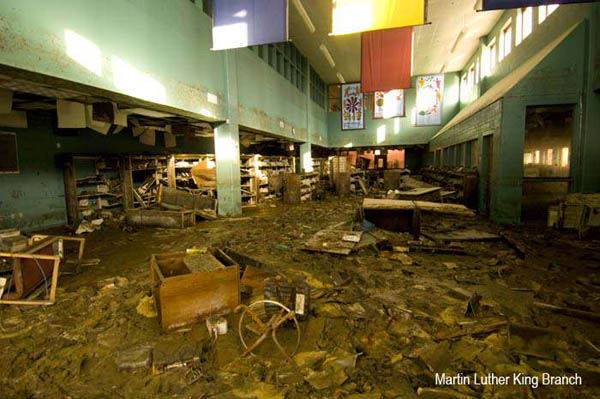
Recently in New Orleans, I was working at AAUP‘s annual meeting of university presses. At the opening banquet, Times-Picayune editor Jim Amoss brought a large audience of publishing folk through a blow-by-blow of New Orleans’ storm last fall. What I found particularly resonant in his recount, beyond his staff’s stamina in the face of “the big one”, was the Big Bang phenomena that occured in tandem with the flooding, instantly expanding the relationship between their print and internet editions.
Their print infrastructure wrecked, The Times-Picayune immediately turned to the internet to broadcast the crisis that was flooding in around them. Even the more troglodytic staffers familiarized themselves with blogging and online publishing. By the time some of their print had arrived from offsite and reporters were using it as currency to get through military checkpoints, their staff had adapted to web publishing technologies and now, Amoss told me, they all use it on a daily basis.
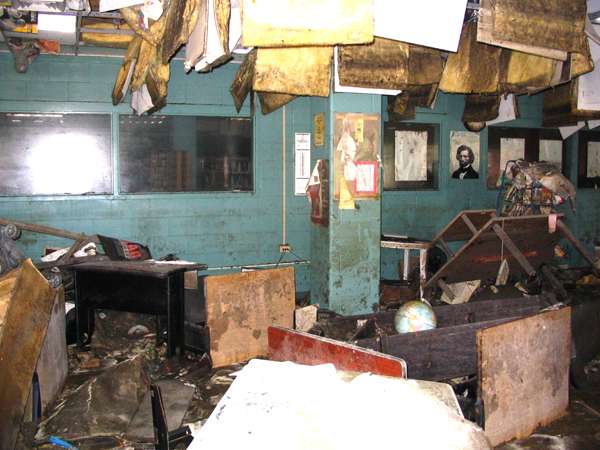
Martin Luther King Branch
If the Times-Picayune, a daily publication of considerable city-paper bulk, can adapt within a week to the web, what is taking university presses so long? Surely, we shouldn’t wait for a crisis of Noah’s Ark proportions to push academe to leap into the future present. What I think Amoss’s talk subtly arrived at was a reassessment of *crisis* for the constituency of scholarly publishing that sat before him.
“Part of the problem is that much of this new technology wasn’t developed within the publishing houses,” a director mentioned to me in response to my wonderings. “So there’s a general feeling of this technology pushing in on the presses from the outside.”
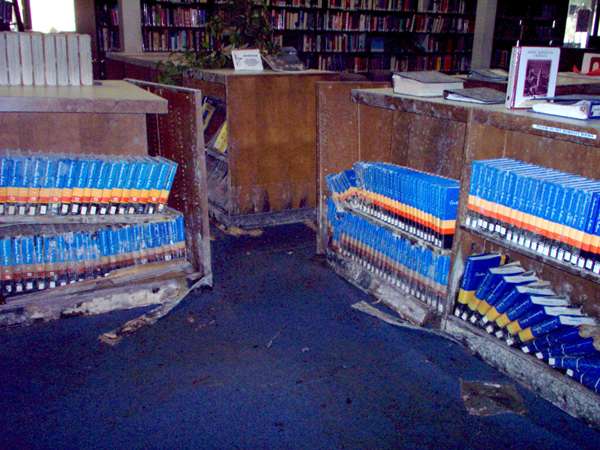
East New Orleans Regional Branch
But “general feeling” belies what were substantially disparate opinions among attendees. Frustration emanated from the more tech-adventurous on the failure of traditional and un-tech’d folks to “get with the program,” whereas those unschooled on wikis and Web 2.0 tried to wrap their brains around the publishing “crisis” as they saw it: outdating their business models, scrambling their workflow charts and threatening to render their print operations obsolete.
That said, cutting through this noise were some promising talks on developments. A handful of presses have established e-publishing initiatives, many of which were conceived of with their university libraries. By piggybacking on the techno-knowledge and skill of librarians who are already digitizing their collections and acquiring digital titles (librarians whose acquisitions budgets far surpass those of many university presses,) presses have brought forth inventive virtual nodes of scholarship. Interestingly, these joint digital endeavors often explore disciplines that now have difficulty making their way to print.
Some projects to look at:
MITH (Maryland); NINES (scholar driven open-access project); Martha Nell Smith’s Dickinson Electronic Archives Project; Rotunda (Virginia); DART (Columbia); Anthrosource (California: Their member portal has communities of interest establishing in various fields, which may evolve into new journals.)
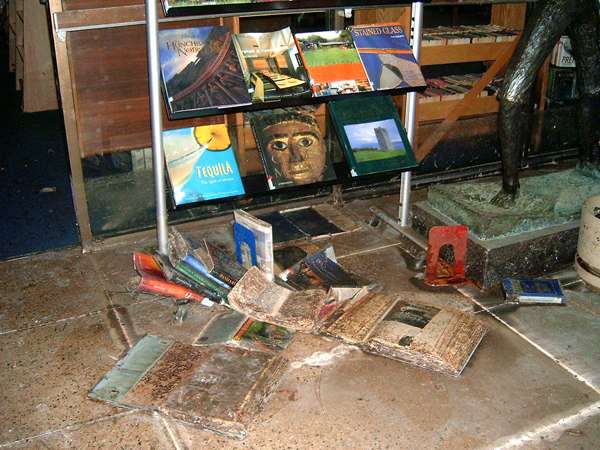
East New Orleans Regional Branch
While the marriage of the university library and press serves to reify their shared mandate to disseminate scholarship, compatibility issues arise in the accessibility and custody of projects. Libraries would like content to be open, and university presses prefer to focus on revenue generating subscribership.
One Digital Publishing session shed light on more theoretical concerns of presses. As MLA reviews the tenure system, partly in response to the decline of monograph publication opportunities, some argued that the nature of the monograph (sustained argument and narrative) doesn’t lend itself well to online reading. But, as the monograph will stay, how do presses publish them economically?
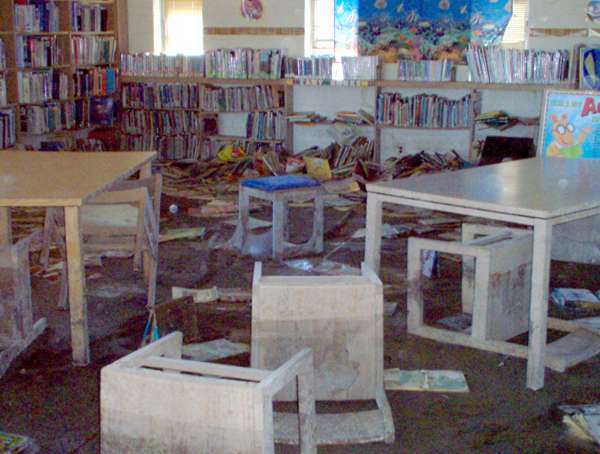
Nora Navra Branch
On the peer review front, another concern critiqued the web’s predominantly fact-based interaction: “The web seems to be pushing us back from an emphasis on ideas and synthesis/analysis to focus on facts.”
Access to facts opens up opportunities for creative presentation of information, but scholarly presses are struggling with how interpretive work can be built on that digitally. A UVA respondant noted, “Librarians say people are looking for info on the web, but then moving to print for the interpretation; at Rotunda, the experience is that you have to put up the mass of information allowing the user to find the raw information, but what to do next is lacking online.”
Promising comments came from Peter Brantley (California Digital Library) on the journal side: peer review isn’t everything and avenues already exist to evaluate content and comment on work (linkages, citation analysis, etc.) To my relief, he suggested folks look at the Institute for the Future of the Book, who are exploring new forms of narrative and participatory material, and Nature’s experiments in peer review.
Sure, at this point, there lacks a concrete theoretical underpinning of how the Internet should provide information, and which kinds. But most of us view this flux as its strength. For university presses, crises arise when what scholar Martha Nell Smith dubs the “priestly voice” of scholarship and authoritative texts, is challenged. Fortifying against the evolution and burgeoning pluralism won’t work. Unstifled, collaborative exploration amongst a range of key players will reveal the possiblities of the terrain, and ease the press out of rising waters.

Robert E. Smith Regional Branch
All images from New Orleans Public Library
